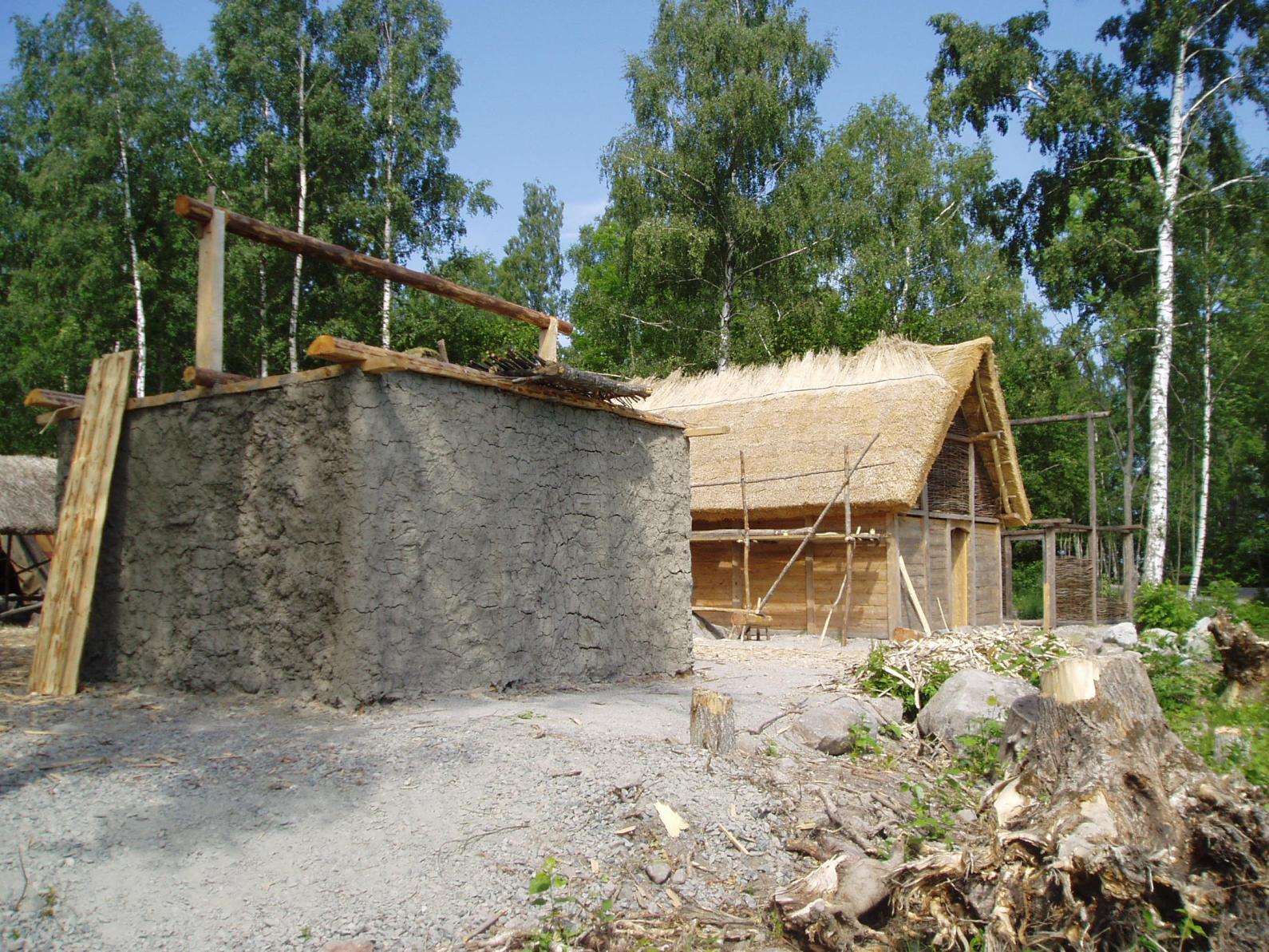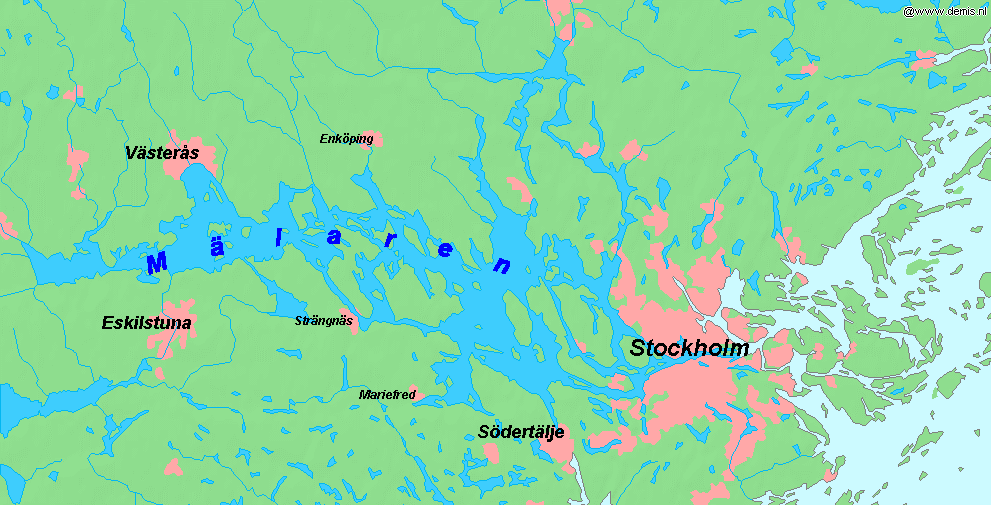|
Lovön
Lovön is an island in the Swedish Lake Mälaren in Ekerö Municipality of Stockholm County. It was a municipality of its own until 1952, when it was joined with Ekerö Municipality. Lovön's greatest attraction is Drottningholm Palace and its many public gardens, which were built on the island in 1580. History There is much known about the history of this rather small island. Owing to its status today as a World Heritage Site, much research has gone into its history. It is estimated that Lovön has been inhabited since around the 25th century BC. Stone Age Traces of Stone Age hunting and fishing camps dated as old as 2500 B.C. have been found by archaeologists on Lovön. Harpoons made of bone, stone tools, ceramic bowls, and remains of huts are some artifacts that have been located and researched. It is also believed that these camps were seasonal quarters rather than year-round habitations. The island was at this point a set of broken-up smaller islands, since the water ... [...More Info...] [...Related Items...] OR: [Wikipedia] [Google] [Baidu] |
Berit Wallenberg
Anna Berit Wallenberg (19 February 1902 – 4 September 1995) was a Swedes, Swedish archaeologist, anthropologist, art historian, photographer, and philanthropist. She established a research foundation, the Berit Wallenberg Foundation, that awards funds to these areas. Since its establishment, it has been providing support to cultural heritage institutions, art historians, and archaeologists. In 1936, she became the first Swedish woman to be appointed as a supervisor for the national heritage committee, responsible for the restoration of the . Berit Wallenberg became the only woman to receive an honorary doctorate from the Stockholm University. Her career was devoted to various forms of research, local history, and the preservation of monuments. Scientific knowledge, Christian beliefs, and local historical work, especially around Drottningholm, Drottningholm Island and Lovå, became the most significant aspects of her life. Throughout her career, she participated in numerous arch ... [...More Info...] [...Related Items...] OR: [Wikipedia] [Google] [Baidu] |
Ekerö Municipality
Ekerö Municipality () is a municipalities of Sweden, municipality in the Provinces of Sweden, province of Uppland in Stockholm County in east central Sweden. The name derives from the name of the main island within the municipality whose name is Ekerön, and literally means "Oak Island". Its seat is located in the town of Ekerö. Carl XVI Gustaf of Sweden, The King of Sweden resides in Ekerö Municipality, at Drottningholm Palace (see below). Originally, when the first local government acts were implemented in Sweden in 1863, eight rural municipalities were created, each corresponding to an old parish. The municipal reform of 1952 grouped them in two new larger entities. The next reform in 1971 merged them into the present municipality. Geography Ekerö is the only municipality in the Mälaren, Lake Mälaren region composed exclusively of islands. Post-glacial rebound, Land elevation has reduced the number of islands and Skerry, skerries to 140, the largest of which are Adels� ... [...More Info...] [...Related Items...] OR: [Wikipedia] [Google] [Baidu] |
National Defence Radio Establishment (Sweden)
The National Defence Radio Establishment (, FRA) is a Swedish government agency organised under the Ministry of Defence. The two main tasks of FRA are signals intelligence (SIGINT), and support to government authorities and state-owned companies regarding computer security. The FRA is not allowed to initialize any surveillance on their own, and operates purely on assignment from the Government, the Government Offices, the Armed Forces, the Swedish National Police Board and Swedish Security Service (SÄPO). Decisions and oversight regarding information interception is provided by the Defence Intelligence Court and the Defence Intelligence Commission; additional oversight regarding protection of privacy is provided by the Swedish Data Protection Authority. History Signals Intelligence has existed in Sweden since 1905 when Swedish General Staff and Naval Staff respectively, had departments for signals intelligence and cryptanalysis. These departments succeeded, for instance ... [...More Info...] [...Related Items...] OR: [Wikipedia] [Google] [Baidu] |
Drottningholm Palace
Drottningholm Palace (), or Drottningholm, one of Sweden's royal palaces, situated near Sweden's capital Stockholm, is the private residence of the Swedish royal family. Located on Lovön island in Stockholm County's Ekerö Municipality, it was built in the late 17th century and was a regular summer residence of the Swedish royal court through most of the 18th century. Drottningholm Palace is a popular tourist attraction. History Origin The name ''Drottningholm'' (literally meaning "Queen's islet") came from the original renaissance building designed by Willem Boy, a stone palace built by John III of Sweden in 1580 for his queen, Catherine Jagiellon. This palace was preceded by a royal mansion called ''Torvesund''. The Queen Dowager Regent Hedwig Eleonora bought the castle throughout 1661, a year after her role as queen of Sweden ended, but it burnt to the ground on 30 December that same year. Hedwig Eleonora engaged the architect Nicodemus Tessin the Elder to ... [...More Info...] [...Related Items...] OR: [Wikipedia] [Google] [Baidu] |
Mälaren
Mälaren ( , , or ), historically referred to as Lake Malar in English, is the third-largest freshwater lake in Sweden (after Vänern and Vättern). Its area is and its greatest depth is 64 m (210 ft). Mälaren spans from east to west. The lake drains, from south-west to north-east, into the Baltic Sea through its natural outlets Norrström and Söderström (as it flows around Stadsholmen island) and through the artificial Södertälje Canal and Hammarbyleden waterway. The easternmost bay of Mälaren, in central Stockholm, is called Riddarfjärden. The lake is located in Svealand and bounded by the provinces of Uppland, Södermanland and Västmanland. The two largest islands in Mälaren are Selaön () and Svartsjölandet (). Mälaren is low-lying and mostly relatively shallow. Being a quite narrow and shallow lake, Mälaren has bridge crossings between Eskilstuna and Västerås with two crossings on the western end at Kvicksund and three separate bridges between St ... [...More Info...] [...Related Items...] OR: [Wikipedia] [Google] [Baidu] |
Runsten U47
A hundred is a geographic division formerly used in northern Germanic countries and related colonies, which historically was used to divide a larger region into smaller administrative divisions. The equivalent term in Swedish is (in Uppland also known as during the early Middle Ages); in Danish and Norwegian, ; in Finnish, ; and in Estonian, . The Scanian hundreds were Danish until the Treaty of Roskilde The Treaty of Roskilde was negotiated at Høje Taastrup Church and was concluded on 26 February ( OS) or 8 March 1658 ( NS) during the Second Northern War between Frederick III of Denmark–Norway and Karl X Gustav of Sweden in the Danish ci ... of 1658. List {{DEFAULTSORT:Hundreds Of Sweden, List Of Hundreds ... [...More Info...] [...Related Items...] OR: [Wikipedia] [Google] [Baidu] |
Nicodemus Tessin The Elder
Nicodemus Tessin the Elder () (7 December 1615 – 24 May 1681) was an important Swedish architect. Biography Nicodemus Tessin was born in Stralsund in Pomerania and came to Sweden as a young man. There he met and worked with the architect Simon de la Vallée. He worked for the Swedish Chancellor Axel Oxenstierna before he travelled for further studies to Germany, Italy, France and in the Netherlands, where he got to know the new Baroque style in architecture. Back in Sweden he rebuilt Borgholm Castle, then built Skokloster Castle and the Wrangel Palace in Stockholm. His most important work was Drottningholm Palace, now a world heritage site. Upon his death his son Nicodemus Tessin the Younger continued his projects. Selected works * Borgholm Castle * Drottningholm Palace * Bonde Palace * Skokloster Castle * Strömsholm Palace * Näsby castle * Stenbock Palace * Wrangel Palace * Bååt Palace * Kalmar Cathedral Literature * K. Neville, ''Nicodemus Tessin the Elde ... [...More Info...] [...Related Items...] OR: [Wikipedia] [Google] [Baidu] |
Sanctuary
A sanctuary, in its original meaning, is a sacred space, sacred place, such as a shrine, protected by ecclesiastical immunity. By the use of such places as a haven, by extension the term has come to be used for any place of safety. This secondary use can be categorized into human sanctuary, a safe place for people, such as a political sanctuary; and non-human sanctuary, such as an animal or plant sanctuary. Religious sanctuary ''Sanctuary'' is a word derived from the Latin , which is, like most words ending in , a container for keeping something in—in this case holy things or perhaps cherished people (/). The meaning was extended to places of holiness or safety. Its origin is the principle of independence and immunity of religious orders from "temporal" powers. In many Place of worship, religious buildings ''sanctuary'' has a specific meaning, covering part of the interior. Sanctuary as area around the altar In many Western Christianity, Western Christian traditions in ... [...More Info...] [...Related Items...] OR: [Wikipedia] [Google] [Baidu] |
Lovo Kyrka 2008
An earth oven, ground oven or cooking pit is one of the simplest and most ancient cooking structures. The earliest known earth oven was discovered in Central Europe and dated to 29,000 BC. At its most basic, an earth oven is a pit in the ground used to trap heat and bake, smoke, or steam food. Earth ovens have been used in many places and cultures in the past, and the presence of such cooking pits is a key sign of human settlement often sought by archaeologists. Earth ovens remain a common tool for cooking large quantities of food where no equipment is available. They have been used in various civilizations around the world and are still commonly found in the Pacific region to date. To bake food, the fire is built, then allowed to burn down to a smoulder. The food is then placed in the oven and covered. This covered area can be used to bake bread or other various items. Steaming food in an earth oven covers a similar process. Fire-heated rocks are put into a pit and are covered ... [...More Info...] [...Related Items...] OR: [Wikipedia] [Google] [Baidu] |
UNESCO
The United Nations Educational, Scientific and Cultural Organization (UNESCO ) is a List of specialized agencies of the United Nations, specialized agency of the United Nations (UN) with the aim of promoting world peace and International security, security through international cooperation in education, arts, sciences and culture. It has 194 Member states of UNESCO, member states and 12 associate members, as well as partners in the Non-governmental organization, non-governmental, Intergovernmental organization, intergovernmental and private sector. Headquartered in Paris, France, UNESCO has 53 regional field offices and 199 National Commissions for UNESCO, national commissions. UNESCO was founded in 1945 as the successor to the League of Nations' International Committee on Intellectual Cooperation.English summary). UNESCO's founding mission, which was shaped by the events of World War II, is to advance peace, sustainable development and human rights by facilitating collaboratio ... [...More Info...] [...Related Items...] OR: [Wikipedia] [Google] [Baidu] |
Johan III
John III (; 20 December 1537 – 17 November 1592) was King of Sweden from 1569 until his death. He attained the Swedish throne after a rebellion against his half-brother Erik XIV. He is mainly remembered for his attempts to close the gap between the newly established Lutheran Church of Sweden and the Catholic Church, as well as his conflict with and possible murder of his brother. John was also, quite autonomously, the Duke of Finland from 1556 to 1563. In 1581 he assumed the title Grand Duke of Finland. His first wife was Catherine Jagiellon of the Polish–Lithuanian ruling family, and their son Sigismund eventually ascended both the Polish–Lithuanian and Swedish thrones. He ended the Northern Seven Years' War, but instead Sweden was drawn into the 25 Years' War with Russia, where minor gains were eventually made. He worked for closer relations with Poland. John III was interested in religion and culture. During his reign, he countered the growing Lutheran tendencies of ... [...More Info...] [...Related Items...] OR: [Wikipedia] [Google] [Baidu] |



